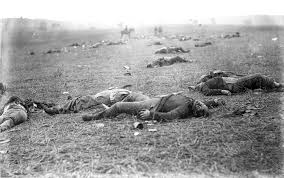Every year, millions of Americans eagerly await Groundhog Day on February 2, when Punxsutawney Phil, the beloved groundhog, emerges from his burrow to predict whether we’ll experience six more weeks of winter. This tradition, while charming, is steeped in legend and folklore. However, did you know that the story of “Groundhog Day” in Ohio goes beyond the famous rodent and even further back in history?
In the midst of the American Civil War, Ohio soldiers, known as the “Groundhog Regiment,” earned their unique name not from the weather but because of their remarkable ability to dig trenches and fortifications on the battlefield. This nickname, though seemingly whimsical, has a deep connection to survival, strategy, and the grit shown by these soldiers during some of the war’s most bloody battles.
The Origins of the Groundhog Regiment
The story of Ohio’s Groundhog Regiment began during the Civil War in 1861. The 26th Ohio Volunteer Infantry was organized at Camp Chase in Columbus, Ohio, and included soldiers from across the state. Unlike many regiments that were composed of men from similar backgrounds, the 26th Ohio was diverse. Soldiers came from all walks of life, varying in class, culture, and faith, but they shared a single goal: to preserve the Union.
Regimental Chaplain Leander Long remarked in 1861 about the unity of the men in the regiment, despite their differences. He said, “There seems to be gathered together every kind of man in our regiment, but there is one thing on which they all agree. They are determined to maintain and defend the Stars and Stripes.”
These men were quickly thrust into combat as the Civil War intensified. Their diverse backgrounds and differing perspectives made them an interesting mix, but it was their teamwork, discipline, and specific military skills that made them memorable in history.
Mastering the Art of Entrenching
As the war went on, one of the critical skills that soldiers learned was how to dig in—literally. The soldiers of the 26th Ohio became especially skilled at creating earthworks and defensive positions, which was essential for survival. With their bayonets, spoons, and canteen cups, they would create trenches, entrenchments, and protective positions at a moment’s notice. The ability to dig in quickly and effectively could be the difference between life and death during a battle.
Soldiers quickly realized that trenches, or “earthworks,” were vital to protecting themselves from enemy fire. Given the Union’s pressing need for fresh troops, these soldiers learned this life-saving skill on the job—often with little formal training.
The Battle of Chickamauga: A Pivotal Moment for the Groundhog Regiment
The 26th Ohio Volunteer Infantry gained their nickname, the “Groundhog Regiment,” due to their extraordinary ability to entrench. However, their entrenching skills would be put to the ultimate test during one of the bloodiest battles of the Civil War: the Battle of Chickamauga in September 1863.
In this critical battle, the Union’s Army of the Cumberland faced off against Confederate forces under General Braxton Bragg in northern Georgia. The 26th Ohio found themselves on the front lines, and despite their reputation for digging in, there was little time for them to prepare. The battle was chaotic, and the soldiers were forced to fight in open fields with minimal cover.
In a vivid account, Private James Treahorn of the 26th Ohio described the fierce fighting at Chickamauga: “Our boys met them steadily; demoniac yells filled the air, mingled with the groans of the dying. Though [we] were forced back by superior number, [we] rallied and drove [off] the enemy.”
Unfortunately, the regiment’s ability to dig in was rendered useless during this battle. The Confederate forces were able to attack from concealed positions in the trees, using the cover of the forest to deliver devastating fire on the Union soldiers. In a battle where casualties were overwhelming, the Groundhog Regiment suffered some of their heaviest losses.
The horrors of Chickamauga underscored the importance of entrenching in combat, and yet it was also a reminder of the brutal nature of war. The soldiers of the 26th Ohio, despite their proficiency in earthworks, could not always depend on their skills in a fast-moving and unpredictable battle.
Trench Warfare: From Civil War to Modern-Day Conflicts
The lessons learned by the 26th Ohio remain relevant to this day. In modern warfare, trenches are still a vital form of defense. Although the technology of combat has changed dramatically since the Civil War, including the introduction of advanced firearms, drones, and artillery, the importance of defensive positions has not faded.
For example, in the ongoing war in Ukraine, trench warfare has made a comeback. Modern soldiers, much like the Groundhog Regiment in the 1860s, face the challenge of surviving under increasingly dangerous conditions. However, today’s soldiers must deal with even more advanced weaponry, such as drones that can drop grenades directly into trench positions. The soldiers in Ukraine, like those in the Civil War, must rely on skillfully constructed defensive positions to stay alive.
Retired Army Lt. Gen. Ben Hodges commented on the modern-day importance of trench warfare, stating, “A combination of concealment from visual detection and thermal imaging is important for surviving in trenches.” Just as trenches were crucial to the Groundhog Regiment during the Civil War, they continue to play a role in protecting soldiers today, even if the weapons and methods have evolved.
The Legacy of the Groundhog Regiment
The 26th Ohio’s nickname, though humorous, carries deep historical significance. It is a testament to the soldiers’ battlefield skills and the crucial role that earthworks and trenches played in military strategy. Despite suffering significant losses during the Battle of Chickamauga, the regiment’s ability to dig in remains a symbol of their tenacity and expertise in combat.
While the nickname might have initially seemed lighthearted, it ultimately reflects the regiment’s grit, determination, and quick thinking in one of the most challenging military environments of the time. And even though the regiment’s trench-digging skills couldn’t save them from the horrors of Chickamauga, the lessons they learned continue to resonate in modern military tactics.
Conclusion
The story of Ohio’s Groundhog Regiment is one of resilience, survival, and skill. While many today celebrate Groundhog Day with a fun prediction from Punxsutawney Phil, Ohioans remember their Groundhog Regiment as a symbol of how practical skills, like digging in, can make the difference between life and death in war. Their legacy reminds us that sometimes, in the most dangerous situations, digging in can be more important than any weapon.
Disclaimer – Our editorial team has thoroughly fact-checked this article to ensure its accuracy and eliminate any potential misinformation. We are dedicated to upholding the highest standards of integrity in our content.





More Stories
The Civil War Story Behind Ohio’s Groundhog Regiment and Its Legacy in Modern Warfare
The Civil War Story Behind Ohio’s Groundhog Regiment and Its Legacy in Modern Warfare
The Civil War Story Behind Ohio’s Groundhog Regiment and Its Legacy in Modern Warfare